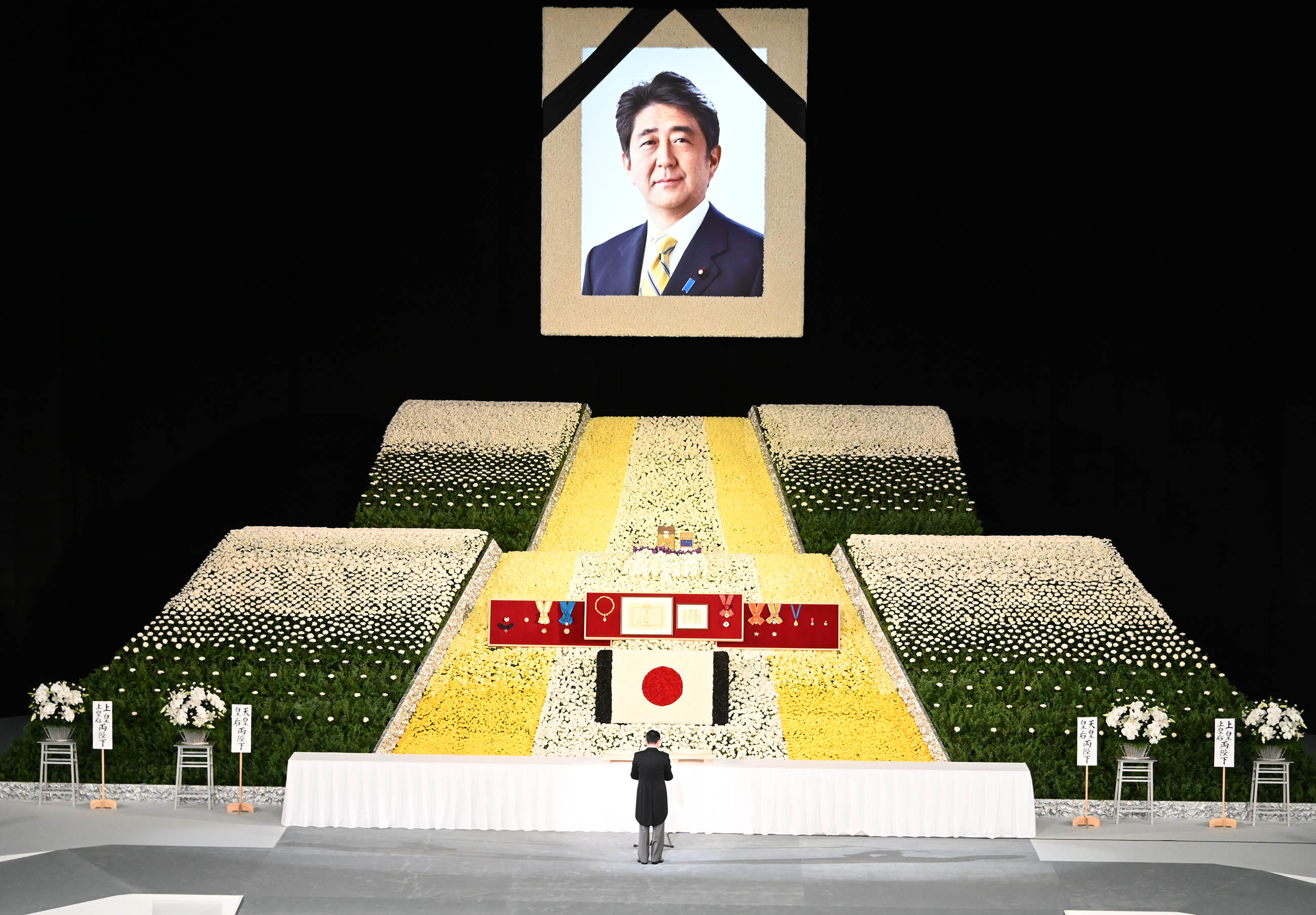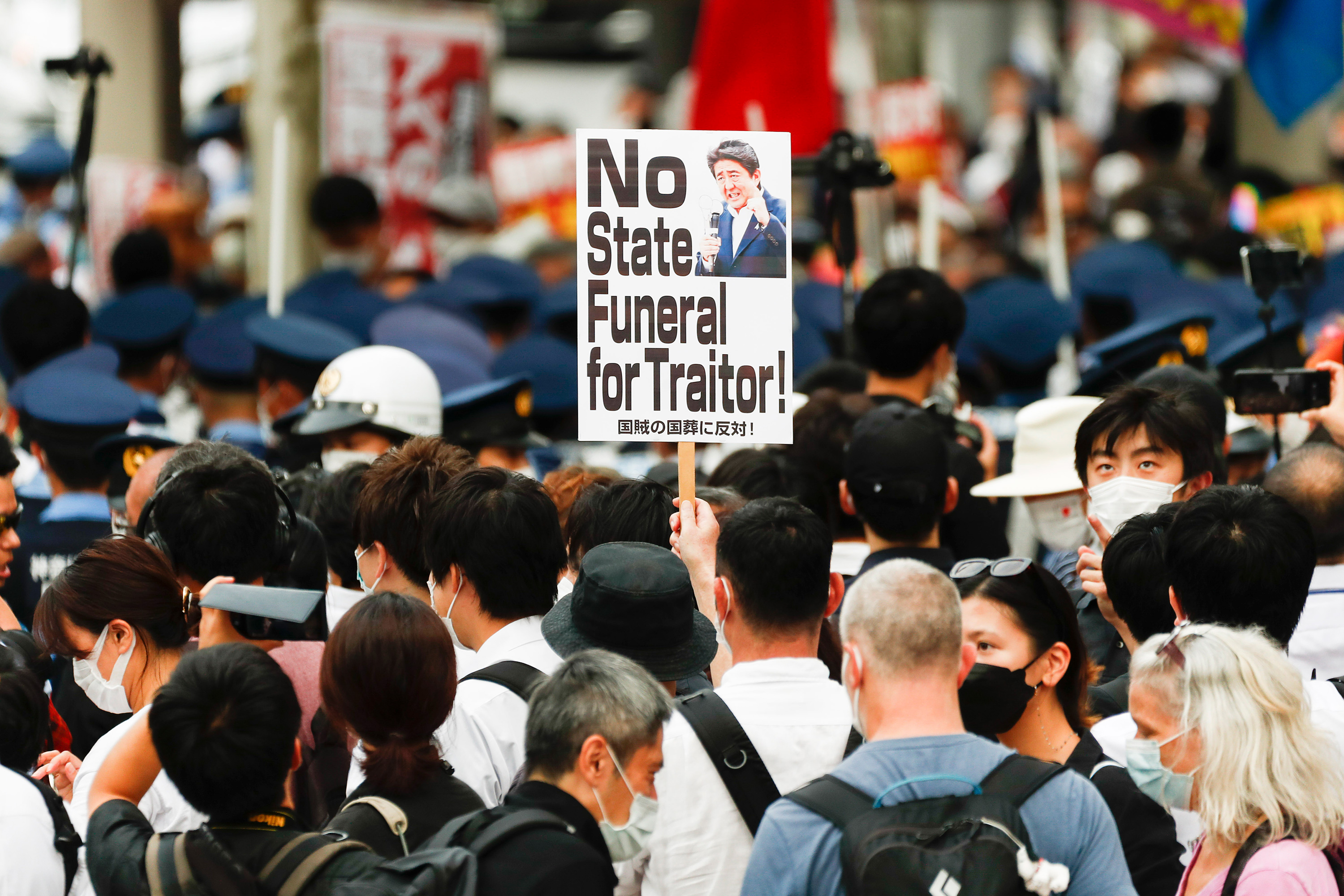Issue:
October 2022
Abe’s state funeral was a politically motivated attempt to secure a shining legacy

Less than a week after the assassination of Shinzo Abe on July 8, the current prime minister, Fumio Kishida, announced the government’s decision to hold a state funeral for the slain politician. The move, announced just days after Abe was cremated at a private ceremony, unleashed havoc.
Opinion polls showed than more than a half of Japanese people opposed the state funeral. But it went ahead anyway.
The controversy Kishida’s decision created created will not subside anytime soon. It will continue to influence debate in the Diet and may well go down as a pivotal moment in modern Japanese history.
On July 14, Kishida tried to justify his decision. Abe, he said, had become prime minister out of a sense of duty to the country, which faced serious challenges on the domestic and international fronts. And he served over two terms for a total of eight years and eight months, making him Japan’s longest-serving prime minister. Moreover, Abe left office with several impressive achievements under his belt, including the reconstruction of the region hit by the March 2011 triple disaster. In addition, he had revitalized Japan’s economy and strengthened security ties with the US. All this, Kishida argued, was nothing short of magnificent.
But he did not explain the legal basis for his decision at that press conference. That came later, in answer to a reporter’s question. Without that question, there would have been no explanation. At the same time, Kishida and his cabinet started referring to Abe’s send-off as a kokusogi (state-funded funeral) rather than kokuso (state funeral) in an attempt to quell the controversy.
But he was on shaky legal ground. When, in 1975, the government considered holding a state funeral for former Prime Minister Eisaku Sato, the Cabinet Legislation Bureau warned that the legal basis for doing so was “unclear” and the decision was made not to go ahead with the event.
“Even now, the Cabinet Legislation Bureau should have given the same opinion, because it is a fact. But now that it is little more an advisory body, it does not play that role these days,” Katsuya Okada, secretary general of the Constitutional Democratic Party of Japan, told journalists earlier this month. This state of affairs is one of the negative consequences of Abe’s premiership, Okada added, since under him the bureau had become a facilitator of the Kantei’s wishes. “Even so, everyone who is familiar with the law knows that a state funeral is legally not possible.”

Kenichi Yoshida, president of the Japan Lawyers Association for Freedom, said the cabinet's decision had no legal basis and "should not escape criticism as an arbitrary use of government funds based on political motives. It is impermissible under the constitution, which states that ‘the power to administer national finances shall be exercised as the Diet shall determine’”.
Kishida faced a flurry of questions from legal experts, journalists and Diet members about the legal questions hanging over the state funeral, but repeatedly said only that the cabinet had the right to take the decision alone. It was a repeat of a memo written by bureaucrats and a betrayal of the promise he frequently made to offer “precise explanations” to the Japanese people.
The chief cabinet spokesman, Hirokazu Matsuno, was unable to explain the difference between kokusogi and kokuso, and when asked for the English translations, simply referred reporters to the foreign ministry. The ministry eventually came up with a single English translation for both words – state funeral – since state-funded funeral would have been a less prestigious proposition for foreign guests and the visiting international media.
The scheduling was also problematic, since September 27 came soon after the UN general assembly in New York. How could Japan’s government expect a large number of world leaders to come from Europe and America after such an important diplomatic event, irrespective of Kishida’s determination to use the funeral as an opportunity for “condolence diplomacy”?
Kishida did hold brief meetings with the leaders of some Asian countries, but, notably, there were no G7 leaders in attendance. Kishida spent 15 minutes with France’s former president, Nicolas Sarkozy. A meaningless Kantei statement said the two men had “confirmed that they would continue to work closely on the various challenges facing the international community”. Sarkozy no longer has a political role in France and faces verdicts in a campaign finance trial.
The state funeral of Queen Elizabeth II posed an additional challenge for Japan. “Given the criticism he was facing, Kishida should have used this as a reason to cancel the Abe state funeral,” said a French expert on Japanese diplomacy. It is still not clear if Kishida himself was 100% in favor of Abe's state funeral, but there is little doubt that he saw the event as an opportunity to secure an exclusively positive legacy for his friend and mentor.
The well-orchestrated ceremony may have gone a long way towards achieving this goal. In this sense, the media have an important role to play. Coverage of the controversy in the days and weeks before the state funeral - petitions, demonstrations, and press conferences by legal experts - along with reporting on the negative reality of the Abe premiership, including a string of major scandals, will serve as a multilingual archive and proof that, for all the pomp on display at the Budokan, Abe was far from universally admired.
Karyn Nishimura is a correspondent for the French daily newspaper Libération and Radio France.

